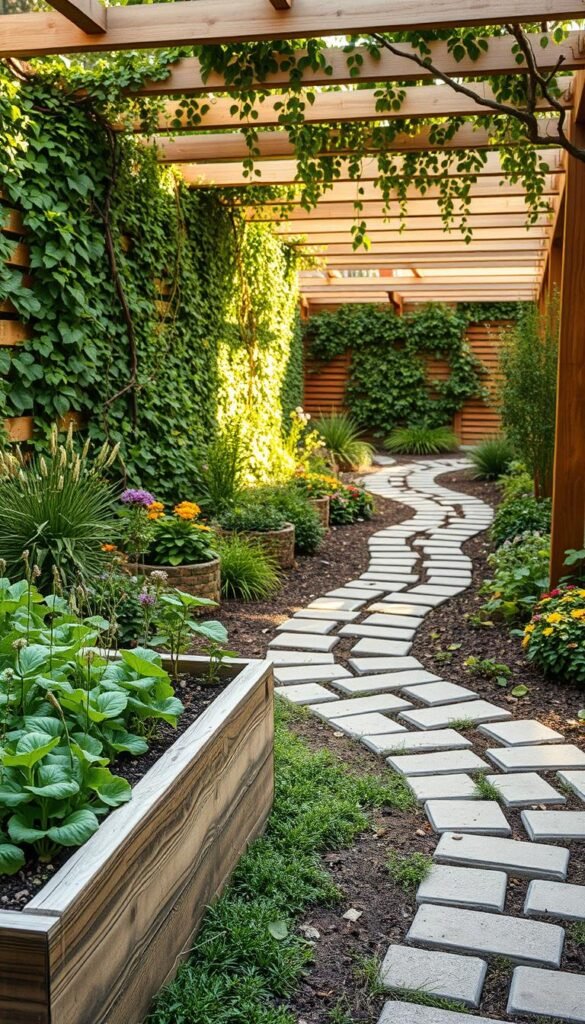Transforming your outdoor area into a thriving green space doesn’t require sacrificing style or breaking the bank. By choosing resource-smart options, you can craft a beautiful landscape that aligns with nature’s rhythms. These approaches not only save money but also minimize upkeep while protecting natural ecosystems.
Imagine using bamboo for sleek fencing or repurposing old steel into rustic planters. Materials like cork mulch and hemp-based fabrics blend durability with earth-conscious benefits. Many of these options outlast traditional choices, proving cost-effective over years of use.
Beyond selecting the right components, this philosophy encourages holistic thinking. For example, fabric containers made from recycled plastics offer better root health while reducing waste. Such choices create habitats for pollinators and local wildlife, boosting biodiversity in your backyard.
You’ll discover how these strategies help conserve water, reduce chemical use, and adapt to your regional climate. Whether you’re building raised beds or designing pathways, every decision becomes an opportunity to support environmental balance. Let’s explore how thoughtful planning can turn your yard into a resilient, living ecosystem that thrives season after season.
Understanding Eco-Friendly Garden Design Principles
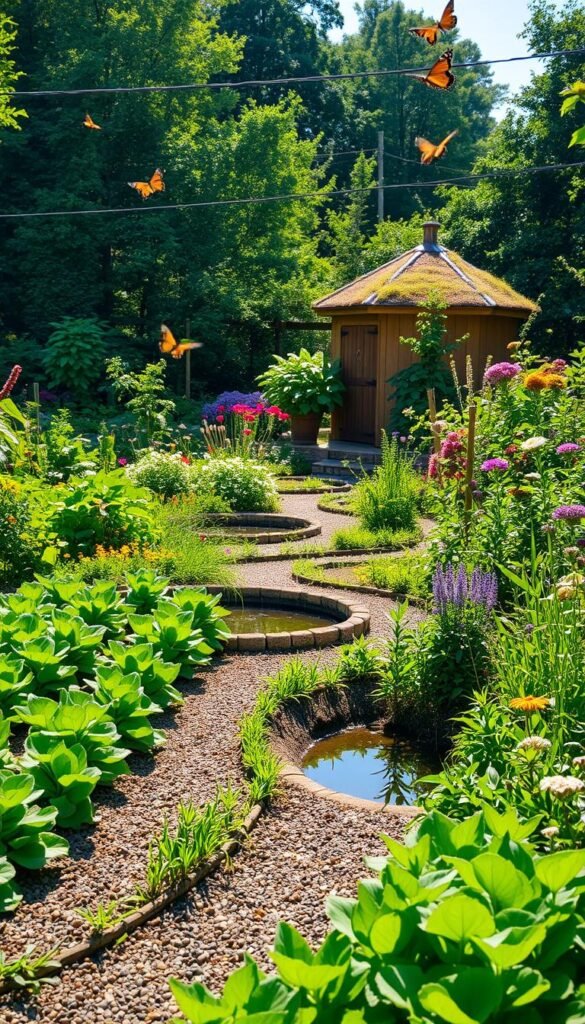
A nature-friendly garden flourishes when you align your choices with ecological balance. Start by observing how sunlight, rainfall, and soil interact in your space. This awareness helps you select plants that thrive naturally, reducing the need for extra care.
Smart gardening practices focus on creating partnerships with local ecosystems. For example, choosing native shrubs attracts pollinators while resisting pests. You’ll spend less time battling weeds and more enjoying your vibrant outdoor area.
Consider these key differences when planning:
| Aspect | Traditional Approach | Eco-Friendly Approach |
|---|---|---|
| Water Use | Daily sprinklers | Rainwater harvesting |
| Plant Selection | High-maintenance flowers | Drought-resistant natives |
| Materials | Plastic edging | Reclaimed stone borders |
Your local climate plays a starring role. A sustainable garden in Arizona will look different than one in Oregon. Use regional plants to create habitats for butterflies and birds. This eco-conscious landscaping guide offers location-specific tips.
By working with nature’s patterns, you’ll build a space that grows healthier each year. Less watering. Fewer chemicals. More life buzzing through your backyard.
Exploring Innovative Sustainable Materials for Eco-Friendly Garden Design
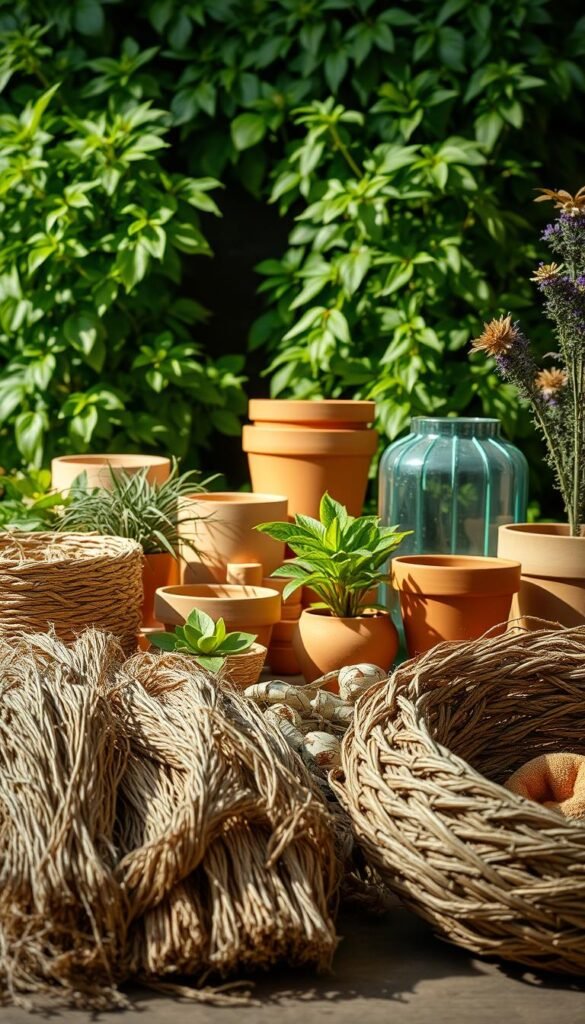
Your garden’s sustainability journey begins with thoughtful material selections that balance aesthetics and environmental impact. Modern options like bamboo, cork, and hemp-based products redefine what’s possible in outdoor spaces. These earth-friendly alternatives often require less upkeep than traditional wood or concrete.
Recycled steel transforms into sleek planters or decorative accents, while reclaimed wood adds rustic charm to benches and raised beds. Cork mulch not only suppresses weeds but also improves soil health as it breaks down. For vertical design elements, consider hemp fabric panels that let climbing plants thrive.
| Material | Best Use | Key Benefit |
|---|---|---|
| Bamboo | Fencing & Trellises | Rapidly renewable |
| Recycled Plastic | Pathways | Water-permeable |
| Reclaimed Stone | Edging | Zero-waste production |
| Hempcrete | Planters | Natural pest resistance |
Looking for inspiration? This guide to eco-friendly landscape materials pairs perfectly with creative budget-friendly container gardening approaches. Many of these options last 2-3 times longer than conventional counterparts, saving money over time.
Mix textures and colors to create visual interest while supporting local ecosystems. A stone pathway bordered by bamboo fencing creates natural divisions without harsh chemicals. These conscious choices help your outdoor space become part of nature’s cycle rather than fighting against it.
The Environmental Benefits of a Sustainable Garden
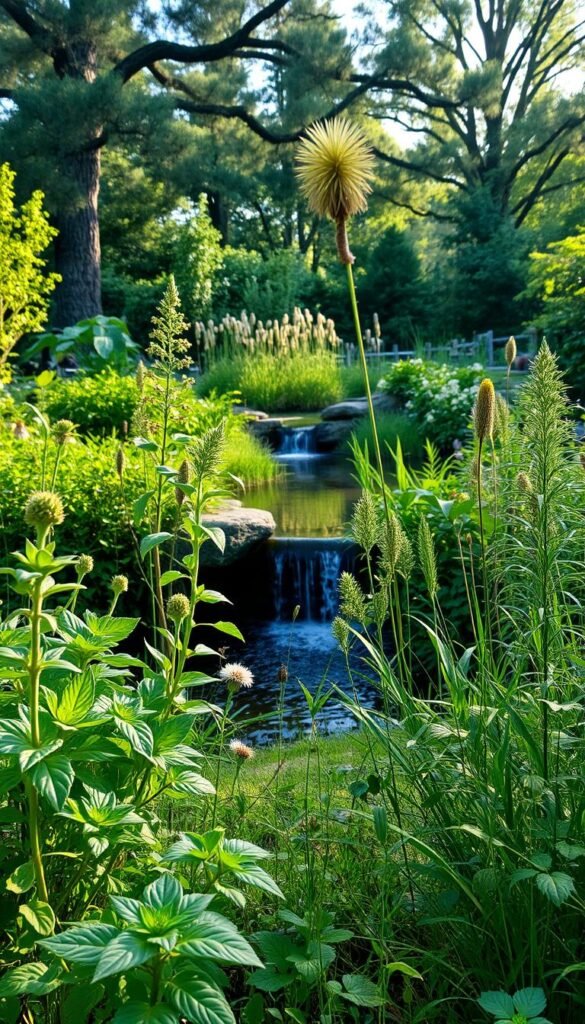
Your backyard can become a climate hero. Trees and shrubs do more than beautify spaces—they absorb carbon dioxide daily. A single mature tree stores up to 48 pounds of carbon annually in its roots and branches.
These natural air filters also trap dust and pollutants. Research shows urban gardens reduce nearby particulate matter by 15-20%. Your choices create ripple effects across the environment.
| Benefit | How It Works | Impact |
|---|---|---|
| Carbon Storage | Trees convert CO₂ into oxygen | Reduces atmospheric carbon |
| Biodiversity Support | Native plants attract pollinators | Strengthens local ecosystems |
| Resource Efficiency | Recycled materials replace new | Cuts manufacturing emissions |
Using reclaimed stone or bamboo fencing helps protect natural habitats. Less demand for virgin resources means fewer forests mined or clear-cut. Over time, your garden becomes a carbon sink that benefits the planet.
Rainwater-permeable pathways prevent runoff pollution. Shade from trees cools surrounding areas by 6-10°F. These combined efforts create lasting positive impact—your green space becomes part of Earth’s healing process.
Maximizing Recycled and Upcycled Materials in Your Garden
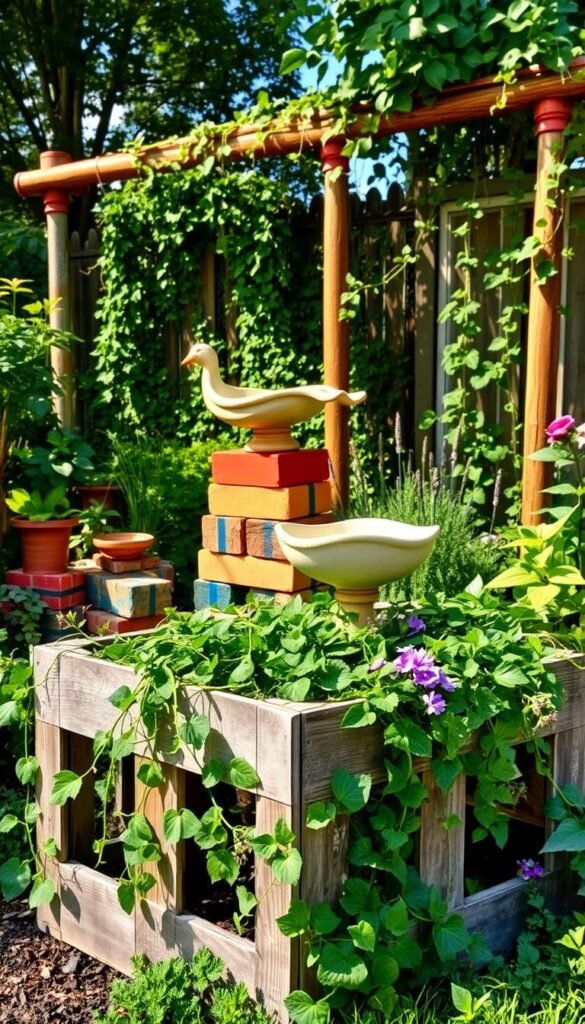
Breathing new life into old items isn’t just creative—it’s a game-changer for your outdoor space. Everyday objects like glass jars, shipping pallets, and broken tiles can become functional garden treasures with minimal effort. This approach keeps usable waste out of landfills while adding personality to your landscape.
Recycled plastic lumber shines for durable decking and fencing. Made from milk jugs and food containers, it resists rot better than wood. For vertical accents, try using recycled steel beams as trellises or pergola frames—they withstand harsh weather while cutting manufacturing emissions.
Simple ways to start upcycling:
- Turn tires into colorful flower beds
- Convert wine bottles into pathway borders
- Transform metal drums into rain barrels
Local salvage yards often stock materials perfect for upcycled container gardening. Always check items for sharp edges or chemical residues before repurposing. A quick sanding or sealant can make most finds safe for plant use.
By choosing these resourceful alternatives, you create a space that tells a story. Each repurposed piece reduces demand for new resources while adding unique charm. Your garden becomes a living showcase of environmental responsibility—one creative project at a time.
Incorporating Natural Elements: Bamboo, Cork, and Hemp
Nature offers powerful solutions for creating outdoor spaces that thrive with minimal effort. Three standout materials—bamboo, cork, and hemp—deliver beauty and function while working in harmony with the environment. Each brings unique advantages that make them smarter choices than synthetic alternatives.
Bamboo matures in just 3-5 years, unlike traditional hardwoods needing decades. Its rapid growth makes it perfect for fencing, trellises, or decorative screens. You’ll love how it withstands weather while adding organic texture to your garden.
| Material | Growth Cycle | Key Benefit | Maintenance Level |
|---|---|---|---|
| Bamboo | 3-5 years | Self-regenerating | Low |
| Cork | Harvested every 9-12 years | Tree-friendly harvesting | Minimal |
| Hemp | Annual crop | Carbon absorption | None |
Cork comes from oak tree bark without harming the tree. It naturally resists moisture and pests, ideal for pathway mulch or planter liners. Pair it with budget-friendly home gardening ideas for an earth-conscious setup.
Hempcrete (hemp mixed with lime) locks away carbon dioxide throughout its lifespan. Use it for planters or garden walls that improve air quality. These plants-based options need little care once installed—perfect for low maintenance spaces.
By choosing these elements, you support farming practices that give back to the land. Your garden becomes part of a larger cycle that nurtures nature instead of depleting it.
Harnessing the Power of Recycled Steel and Reclaimed Wood
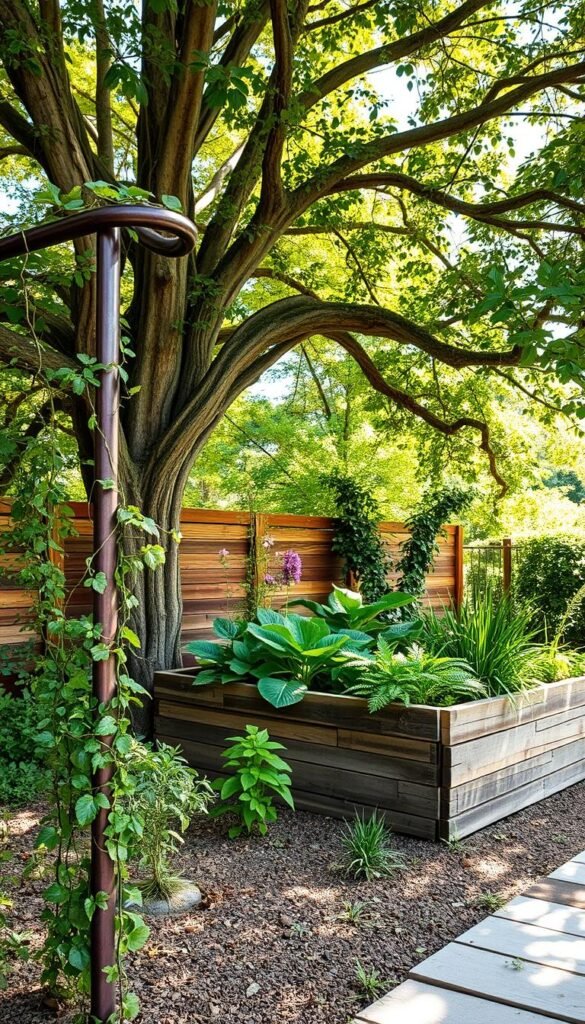
Forging a connection between industrial heritage and natural beauty starts with two powerhouse materials. Recycled steel boasts 56% greater strength than virgin metal, perfect for supporting structures like arbors or greenhouse frames. Meanwhile, reclaimed wood whispers stories through its weathered knots and nail holes—each board carries decades of history.
Why choose these options? They outlast conventional picks while shrinking your environmental footprint. A steel beam from scrapped machinery can weather storms for 50+ years. Old barn wood resists rot better than fresh-cut lumber, having already endured decades of seasoning.
| Material | Strength Advantage | Lifespan | Top Uses |
|---|---|---|---|
| Recycled Steel | 56% stronger than new | 50+ years | Greenhouse frames, pergolas |
| Reclaimed Wood | Pre-hardened | 30+ years | Raised beds, benches |
Pairing these elements creates visual magic. Imagine steel planters overflowing with flowers, anchored by wooden slats from a 1920s factory. This blend cuts mining demands by 72% compared to new materials, according to recent sustainability studies.
Finding quality pieces is easier than you think. Check local salvage yards for beams with character, or visit metal recyclers for affordable structural components. Always ask about a material’s origin—knowing its past adds depth to your garden’s story.
Your design gains durability and charm while keeping tons of waste from landfills. These choices pay off over time, requiring less upkeep than plastic or untreated wood. Let your space become a testament to resilience—both ecological and aesthetic.
Low-Maintenance Materials and Eco-Friendly Gardening Practices
Creating a vibrant outdoor space that practically cares for itself starts with smart choices. By selecting low-maintenance materials, you’ll spend less time on upkeep and more enjoying your retreat. Bamboo fencing needs no staining, while recycled plastic lumber resists rot for decades—no sealing required.
Pair these materials with earth-conscious gardening practices for maximum impact. Turn kitchen scraps into nutrient-rich compost instead of buying bagged soil. Let fallen leaves become natural mulch that suppresses weeds and feeds your plants.
| Material | Key Benefit | Maintenance Saved |
|---|---|---|
| Bamboo | No sealing/staining | 3-5 hours annually |
| Composite Decking | No splinter repairs | 8-10 hours yearly |
| Recycled Plastic Lumber | No pest treatments | 6-8 hours per season |
| Permaculture Design | Self-fertilizing system | 15+ hours monthly |
Smart soil preparation makes plants thrive with minimal help. Mix in compost before planting to boost water retention. Use companion planting instead of chemical pesticides—marigolds deter nematodes while attracting pollinators.
These approaches create a self-reinforcing cycle. Durable materials reduce replacement needs, while healthy soil grows stronger plants that resist pests naturally. You’ll save money and create a sanctuary that grows more resilient each year.
Enhancing Biodiversity with Native Plants and Companion Planting
Your outdoor space becomes a wildlife haven when you work with nature’s existing patterns. By prioritizing regional species, you create habitats that support bees, butterflies, and birds naturally. This approach builds resilience while cutting maintenance time.
Why Native Plants Shine
Local species thrive in your soil and climate without extra watering or fertilizers. Milkweed feeds monarch caterpillars, while purple coneflowers nourish goldfinches. These plants form the backbone of healthy ecosystems, requiring 60% less care than non-natives.
Smart Pairings for Pest Control
Companion planting acts like nature’s security system. Marigolds release chemicals that repel tomato-hungry whiteflies. Onions mask carrot scents from root-eating flies. Such pairings reduce pests without harsh sprays, letting beneficial insects handle the heavy lifting.
These strategies transform your garden into a balanced network where every element supports another. You’ll spend less time battling weeds and more enjoying buzzing pollinators—all while strengthening local biodiversity.

